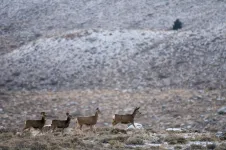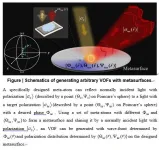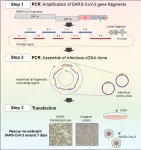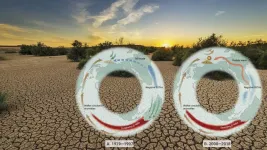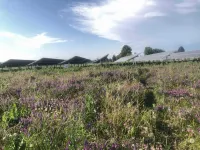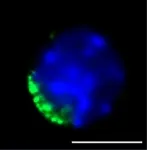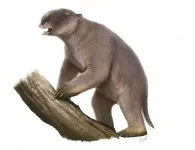INFORMATION:
UW researchers involved in the project were Ellen Aikens, Samantha Dwinnell, Tayler LaSharr, Rhiannon Jakopak, Matt Kauffman and Kevin Monteith. Other contributors were Gary Fralick and Jill Randall, of the Wyoming Game and Fish Department; Rusty Kaiser, of the U.S. Forest Service; and Mark Thonhoff, of the Bureau of Land Management.
Study shows multiple factors shape timing of birth in mule deer
2021-04-13
(Press-News.org) A five-year study of mule deer does and newborn fawns in western Wyoming shows that migrating deer have a lot to balance when it comes to birth timing.
The study led by University of Wyoming scientists challenges the long-held assumption that animals match offspring birth with the peak green-up of forage at the birth site. Instead, only deer that migrated long distances and followed the flush of spring green-up from low elevation winter ranges to higher-elevation summer ranges were able to match birth with peak green-up. Other deer migrated shorter distances and gave birth earlier, but birth was out of sync with green-up.
The researchers' work appears in the journal Ecology.
To examine the factors shaping birth timing, researchers integrated highly detailed data on female deer, including movement data from GPS collars, body condition and gestational development from ultrasonography of adult female deer, and intensive fieldwork to locate newborn fawns.
"In contrast to existing theory, which predicts that conditions at the birth site should shape optimal birth timing, our results provide a clear example of birth timing being shaped by trade-offs arising from events occurring away from the birth site and from other parts of the annual cycle," the researchers wrote.
Migration results in animals having to time important events, such as reproduction, within tight time schedules. In general, mule deer in western Wyoming give birth in early June, generally after migration is over but early enough for fawns to grow large enough to survive the onset of winter. The deer that were part of the study included animals that migrated long distances between winter and summer ranges, as well as those that migrated shorter distances.
Among the study's findings:
Most deer completed migration well before giving birth: Across the five-year period of the study, animals completed migration, on average, 23 days before giving birth.
Does that ended migration earlier gave birth earlier.
Only animals that surfed the green wave and ended migration just before giving birth matched birth with peak green-up, whereas most gave birth after peak green-up.
Although matching birth with peak green-up likely increased access to high-quality forage, doing so resulted in delayed birth and, therefore, less time for offspring to grow and develop before fall migration.
Does appear to trade off early birth and increased time of offspring growth with matching birth to peak green-up.
Animals that migrated long distances had less developed fetuses in March, thereby allowing them to complete migration before giving birth -- without sacrificing the ability to surf the green wave along their migratory route.
"Conceptualizing birth timing through the lens of the full annual cycle helps to illuminate additional trade-offs that migrants face when balancing reproduction with migration, foraging and accumulation of fat reserves," the researchers wrote.
They say the link between movement tactics and timing of birth has important conservation and management implications. For example, human-caused disturbances to migration patterns could harm deer reproduction until animals have time to adjust. Additionally, the diversity of movement behaviors among western Wyoming mule deer is important to preserve, as animal populations with greater life-history diversity have been found to be more able to withstand environmental changes.
ELSE PRESS RELEASES FROM THIS DATE:
Efficient generations of complex vectorial optical fields with metasurfaces
2021-04-13
Light beams are widely used in photonics applications and attracted immense research interests. Compared to homogeneously polarized light beams, vectorial optical fields (VOFs) with tailored wave-fronts and inhomogeneous polarization distributions exhibits more advantages in applications comparing to their scalar-wave counterparts, thanks to the added degree of freedom (DOF) of polarization. By tailoring the polarization distributions, special VOFs such as flap-top beams and radially polarized beams can be generated, being highly favored in super-resolution microscopy, optical manipulations, etc.
Despite of great advances in applications, generation of such complex VOFs are far from satisfactory. Available methods ...
SUTD breaks new ground in 3D printed soft robotics with largest range of polymer hybrids
2021-04-13
In a study published in Applied Materials Today, researchers from Singapore have developed the largest range of silicone and epoxy hybrid resins for the 3D printing of wearable devices, biomedical equipment, and soft robotics. The range of tunable functionally graded materials, which displayed over five orders of magnitude of elastic modulus, demonstrated excellent interfacial toughness, higher precision in complex structures and better fabrication control for the integration of mechatronic components.
The multi-disciplinary team from the Singapore University of Technology and Design (SUTD) highlighted the issue on the potential of soft robotics being limited in its robustness and ...
A novel, quick, and easy system for genetic analysis of SARS-CoV-2
2021-04-13
Osaka, Japan - SARS-CoV-2 is the virus responsible for the COVID-19 pandemic. We know that mutations in the genome of SARS-CoV-2 have occurred and spread, but what effect do those mutations have? Current methods for studying mutations in the SARS-CoV-2 genome are very complicated and time-consuming because coronaviruses have large genomes, but now a team from Osaka University and Hokkaido University have developed a quick, PCR-based reverse genetics system for analyzing SARS-CoV-2 mutations.
This system uses the polymerase chain reaction (PCR) and a circular polymerase extension reaction (CPER) to reconstruct the full-length cDNA of viral genome. This process does not involve the use of bacteria, which can introduce further ...
The relationship between ENSO and Indian summer monsoon rainfall is restoring
2021-04-13
In the 1930s, English climatologist, Sir Gilbert Walker, successfully predicted Indian summer monsoon rainfall (ISMR) based on the relationship between Southern Oscillation and ISMR connected by what is later-called Walker circulation, which is regarded as the first achievement of modern climate prediction with a clear physical mechanism. The Southern Oscillation was also recognized as the atmospheric component of El Nino-Southern Oscillation (ENSO).
However, at the end of the 20th century, a research in Science led by Indian climatologist Krishna Kumar found the significant reverse relationship between ENSO and Indian rainfall has been ...
Abandoning the old ways: Progress in the low-cost electrochemical synthesis of ammonia
2021-04-13
Ammonia (NH3) is among the most important chemicals produced by humans and has a promising future in sustainable energy applications besides being used in fertilizer production. Unfortunately, so far, the only realistic way that exists to produce ammonia at an industrial scale is through the Haber-Bosch process. This technique, discovered in the 19th century, is very energy-intensive and environmentally unfriendly; about 2% of the yearly global CO2 emissions come from Haber-Bosch processes.
"Considering the threats posed by global warming, it is high time we swap to an ammonia synthesis route with zero CO2 emissions," says Professor Sangaraju Shanmugam from Daegu Gyeongbuk Institute of Science and Technology (DGIST), Korea. ...
Student's second-year homework picked up by Amazon quantum researchers
2021-04-13
What started out as a second-year physics project is making its way into Amazon Web Service's (AWS) quantum computing program.
University of Sydney science undergraduate Pablo Bonilla Ataides has tweaked some computing code to effectively double its capacity to correct errors in the quantum machines being designed in the emerging technology sector.
The simple but ingenious change to quantum error correcting code has grabbed the attention of quantum researchers at the AWS Center for Quantum Computing in Pasadena, California, and the quantum technology programs at Yale University and Duke University in the United States.
"Quantum technology is in its infancy, partly because we haven't ...
Partial shade from solar panels increase abundance of flowers in late summer
2021-04-13
CORVALLIS, Ore. - A new study by Oregon State University researchers found that shade provided by solar panels increased the abundance of flowers under the panels and delayed the timing of their bloom, both findings that could aid the agricultural community.
The study, believed to be the first that looked at the impact of solar panels on flowering plants and insects, has important implications for solar developers who manage the land under solar panels, as well as agriculture and pollinator health advocates who are seeking land for pollinator habitat restoration.
The findings, ...
Aged bone marrow niche impedes function of rejuvenated hematopoietic stem cells
2021-04-13
Durham, NC - When leukemia strikes an older person, it is in part due to the aging of his or her hematopoietic stem cells (HSCs). These immature cells can develop into all types of blood cells, including white blood cells, red blood cells and platelets. As such, researchers have focused on rejuvenating HSCs as a way to treat leukemia.
A new study released today in STEM CELLS adds much to that level of knowledge by showing that the youthful function of rejuvenated HSCs upon transplantation depends in part on a young bone marrow "niche," which is the microenvironment surrounding stem cells that interacts with them to regulate their fate.
"The information revealed by our study tells us that the influence of this niche ...
Megafauna extinction mystery - size isn't everything
2021-04-13
Ancient clues, in the shape of fossils and archaeological evidence of varying quality scattered across Australia, have formed the basis of several hypotheses about the fate of megafauna that vanished about 42,000 years ago from the ancient continent of Sahul, comprising mainland Australia, Tasmania, New Guinea and neighbouring islands.
There is a growing consensus that multiple factors were at play, including climate change, the impact of people on the environment, and access to freshwater sources.
Now, research led by Professor Corey Bradshaw of Flinders University and the Australian Research Council Centre of Excellence of Australian Biodiversity and Heritage (CABAH) has used sophisticated mathematical modelling to assess how susceptible different species were to extinction - and what ...
2021 Global Food Policy Report
2021-04-13
April 13th, 2021, Washington, D.C. - The severe health and economic impacts of the COVID-19 pandemic have disrupted food systems and upended livelihoods. Yet pandemic responses have demonstrated the power of well-crafted policies to blunt the impact of major shocks while laying the groundwork for stronger, more resilient food systems, according to the 2021 Global Food Policy Report, released today by the International Food Policy Research Institute (IFPRI). The report provides lessons drawn from the current crisis that can help us transform food systems to reduce the impact of the ongoing pandemic, better prepare for future shocks, and address longstanding weaknesses and inequalities.
"We have known ...
